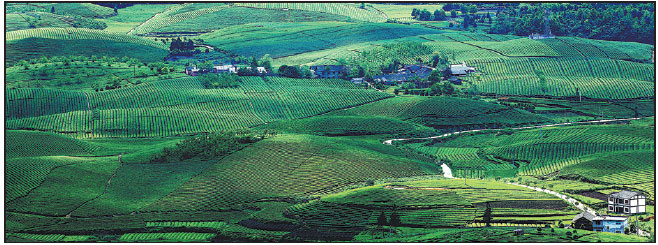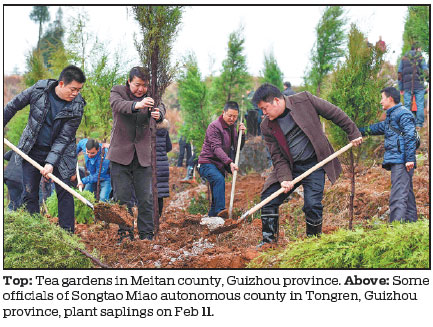
From greening urban wastelands to fighting the effects of desertification, Guizhou aims to tackle its environmental challenges head on, Chen Meiling and Yang Jun report.
Liu Guoyi, an 87-year-old man from Guizhou province, has voluntarily planted over 10,000 saplings over the last three decades. When someone told him afforestation was "government business", he still decided to contribute in his own way.
After retiring from the Guiyang branch of Sinohydro Bureau 8 Co Ltd in 1988, Liu was hired back by the company to oversee the greening of its Guiyang base. After fulfilling his duties, he turned his focus to the area outside of the base. He often paid for saplings and flowers out of his own pocket to plant, and when more of his colleagues joined him, the area of greenery around the compound doubled in size. He also began planting saplings on stretches of wasteland in other areas of the city on Qianchun Road, Changling South Road and Beijing West Road.
In 2011, Liu discovered a 500-meter long strip of riverside wasteland near Qianchun Road strewn with garbage and leftover construction waste. Then an idea struck him: "This place is near a river, so it's a suitable spot for a green belt."
He removed piles of garbage, dug holes, planted saplings and watered plants. He then spruced up the area with more flowers and grass. The number of trees grew to 3,000 through his efforts, which earned him an award for being a trustworthy and moral citizen in Guizhou in 2014.
In 2015, the 3,000 trees Liu planted needed to be removed during the construction of a flyover. After the developer offered him 30,000 yuan in compensation, Liu decided to move the trees to surrounding communities and forests.
He now plants around 20 saplings every day. He sources the saplings from the local forestry authority, finds them in the mountains or buys them at a local market.
"Each tree brings hope, and hope makes life meaningful," he says.
Liu is not the only local obsessed with planting trees. On Feb 11, the first workday after the Lunar New Year holiday, executive and grassroots officials from Guizhou spent the day planting trees in suburban areas - an annual custom that started in 2015.
Sun Zhigang, Party chief of the province, says the local government would work to balance economic development with ecological conservation, on the way to building a more beautiful Guizhou and improving people's livelihoods.
The forest cover of Guizhou province extended to 57 percent of the landmass in 2018, an increase of 10 percentage points within three years. By 2020, this figure is expected to reach 60 percent, officials said at the 2019 forestry work conference held in February.
Data from the National Forestry and Grassland Administration showed that forestry coverage in China stood at 21.66 percent in 2018. The same figure worldwide stands at 30.6 percent, according to a report by the Food and Agriculture Organization of the United Nations.
"The expansion of forestry will help to improve the ecological environment, by preserving the soil and water, creating natural windbreaks, stabilizing the sands and purifying the air," says Li Tao, 31, an engineer at the forest resources management station in Guiyang.
The percentage of days with good air quality in county-level cities and above in the province reached 97 percent last year, a fact that local officials believe is linked to wider forest cover.
The area of rocky desert land fell 18.3 percent from 3.02 million hectares in 2011 to 2.47 million hectares in 2016. Recovery of the vegetation contributed around 67 percent to the reduction, Zhang Fujie, deputy director general of the Guizhou forestry bureau, told a news conference in February.
However, expanding forest cover is by no means a simple process.
To successfully make a barren mountain green, Li and his team have to analyze the soil conditions, assess its density and complexity and select suitable plants before drawing up a design plan to show contractors how to plant the saplings.
"It only succeeds if the survival rate surpasses 80 percent after three years," he says. "If not, we have to try again."
He adds they also have to prevent the spread of plant diseases and insect pests, assess fire risks and put measures in place to stop later deforestation.
"Improving forestry coverage is complicated work that requires joint effort from different departments," he says.
Besides, the karst topography of Guizhou - which has a high calcium carbonate content and soil of poor nutritional value - is a challenging environment for greening, and once the original forest is damaged, it takes multiple rounds of planting to repair it, according to Li.
Methods such as boosting the biodiversity of the surrounding environment, tightening regulations and employing the latest technology are being used to tackle these difficulties.
High-resolution satellite images and mobile internet systems are used to conduct real-time research and monitoring. These tools have significantly helped to prevent illegal operations being carried out in forests.
Han Dan, deputy director of the bureau's public welfare forest management center, says key information about forests, wetlands, sands and residential buildings can show up on the satellite images, which are updated once a year.
"By comparing the results of the previous year, we can figure out whether an area of forest has increased or decreased. If some parts shrink, we will check if these changes were formally approved or contact the police if further action is needed," he says.
"Before the technology was introduced in 2014, we mainly acted on complaints and reports from the public, before sending staff to investigate them by using maps to identify any reduction in tree cover, which was time-consuming and arduous."
The province has introduced extensive measures and legislation to protect forests, from banning the felling or damaging of trees and the illegal picking of wild plants, to prohibiting picnics and other activities that could cause fires, and outlawing the removal of rocks, sands or soils that may damage the vegetation, according to the forestry bureau.
Basic guidelines for the conservation and expansion of forestry include returning farmland to forestry, planting sheltered forests along the Yangtze and Pearl rivers, and controlling desertification, says Zhang.
A study by the journal Natural Sustainability in February found that since 2000 the Earth's green leaf area has increased by 5 percent - an area equivalent to the entire Amazon rainforest.
China contributed to 25 percent of the planet's increase in forest cover, despite having only 6.6 percent of the world's vegetation, the report says.
Contact the writers at chenmeiling@chinadaily.com.cn
Li Hanyi contributed to this story.


|
A densely afforested Wanfeng Lake area, a part of the Xingyi National Geopark in Guizhou province, which is working to balance economic development with ecological conservation. Photos provided to China Daily |
(China Daily 03/04/2019 page14)